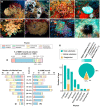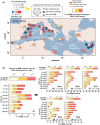Marine heatwaves drive recurrent mass mortalities in the Mediterranean Sea
- PMID: 35848527
- PMCID: PMC9543131
- DOI: 10.1111/gcb.16301
Marine heatwaves drive recurrent mass mortalities in the Mediterranean Sea
Abstract
Climate change is causing an increase in the frequency and intensity of marine heatwaves (MHWs) and mass mortality events (MMEs) of marine organisms are one of their main ecological impacts. Here, we show that during the 2015-2019 period, the Mediterranean Sea has experienced exceptional thermal conditions resulting in the onset of five consecutive years of widespread MMEs across the basin. These MMEs affected thousands of kilometers of coastline from the surface to 45 m, across a range of marine habitats and taxa (50 taxa across 8 phyla). Significant relationships were found between the incidence of MMEs and the heat exposure associated with MHWs observed both at the surface and across depths. Our findings reveal that the Mediterranean Sea is experiencing an acceleration of the ecological impacts of MHWs which poses an unprecedented threat to its ecosystems' health and functioning. Overall, we show that increasing the resolution of empirical observation is critical to enhancing our ability to more effectively understand and manage the consequences of climate change.
Keywords: climate change; coralligenous habitats; foundation species; habitat-forming species; impact assessment; marine conservation; marine heatwaves; temperate reefs.
© 2022 The Authors. Global Change Biology published by John Wiley & Sons Ltd.
Figures




References
-
- Albano, P. G. , Steger, J. , Bošnjak, M. , Dunne, B. , Guifarro, Z. , Turapova, E. , Hua, Q. , Kaufman, D. S. , Rilov, G. , & Zuschin, M. (2021). Native biodiversity collapse in the eastern Mediterranean. Proceedings of the Royal Society B Biological Sciences, 218(1942), 20202469. 10.1098/rspb.2020.2469 - DOI - PMC - PubMed
-
- Arizmendi‐Mejía, R. , Ledoux, J. B. , Antunes, A. , Thanopoulou, Z. , Garrabou, J. , & Linares, C. (2015). Demographic responses to warming: Reproductive maturity and sex influence vulnerability in an octocoral. Coral Reefs, 34, 1207–1216. 10.1007/s00338-015-1332-9h - DOI
-
- Ballesteros, E. (2006). Mediterranean coralligenous assemblages: A synthesis of present knowledge. Oceanography and Marine Biology: An Annual Review, 44, 123–195.
-
- Banzon, V. , Smith, T. M. , Chin, T. M. , Liu, C. , & Hankins, W. (2016). A long‐term record of blended satellite and in situ sea‐surface temperature for climate monitoring, modeling and environmental studies. Earth System Science Data, 8, 165–176. 10.5194/essd-8-165-2016 - DOI
-
- Banzon, V. , Smith, T. M. , Steele, M. , Huang, B. , & Zhang, H.‐M. (2020). Improved estimation of proxy sea surface temperature in the Arctic. Journal of Atmospheric and Oceanic Technology, 37, 341–349. 10.1175/JTECH-D-19-0177.1 - DOI
MeSH terms
LinkOut - more resources
Full Text Sources

